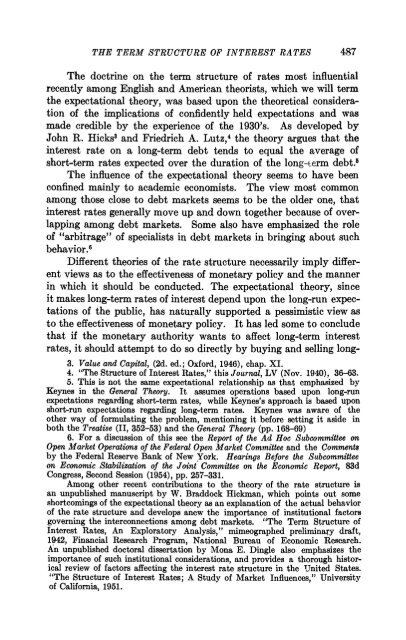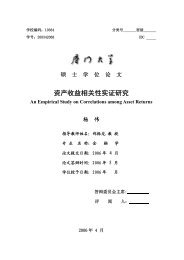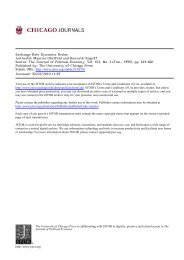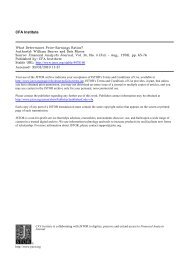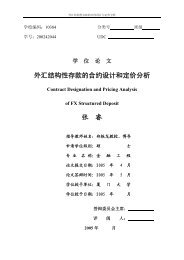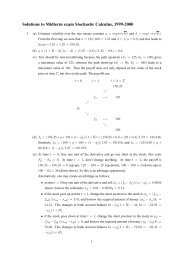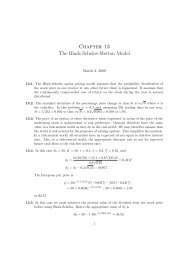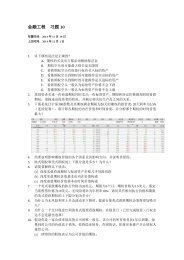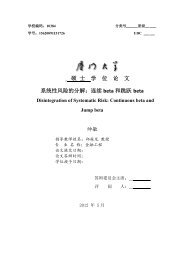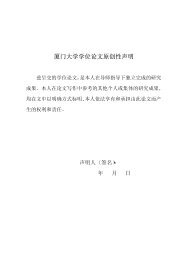The Term Structure of Interest Rates
The Term Structure of Interest Rates
The Term Structure of Interest Rates
Create successful ePaper yourself
Turn your PDF publications into a flip-book with our unique Google optimized e-Paper software.
THE TERM STRUCTURE OF INTEREST RATES 487<br />
<strong>The</strong> doctrine on the term structure <strong>of</strong> rates most influential<br />
recently among English and American theorists, which we will term<br />
the expectational theory, was based upon the theoretical consideration<br />
<strong>of</strong> the implications <strong>of</strong> confidently held expectations and was<br />
made credible by the experience <strong>of</strong> the 1930's. As developed by<br />
John R. Hicks3 and Friedrich A. Lutz,4 the theory argues that the<br />
interest rate on a long-term debt tends to equal the average <strong>of</strong><br />
short-term rates expected over the duration <strong>of</strong> the long-term debt.'<br />
<strong>The</strong> influence <strong>of</strong> the expectational theory seems to have been<br />
confined mainly to academic economists. <strong>The</strong> view most common<br />
among those close to debt markets seems to be the older one, that<br />
interest rates generally move up and down together because <strong>of</strong> overlapping<br />
among debt markets. Some also have emphasized the role<br />
<strong>of</strong> "arbitrage" <strong>of</strong> specialists in debt markets in bringing about such<br />
behavior.6<br />
Different theories <strong>of</strong> the rate structure necessarily imply different<br />
views as to the effectiveness <strong>of</strong> monetary policy and the manner<br />
in which it should be conducted. <strong>The</strong> expectational theory, since<br />
it makes long-term rates <strong>of</strong> interest depend upon the long-run expectations<br />
<strong>of</strong> the public, has naturally supported a pessimistic view as<br />
to the effectiveness <strong>of</strong> monetary policy. It has led some to conclude<br />
that if the monetary authority wants to affect long-term interest<br />
rates, it should attempt to do so directly by buying and selling long-<br />
3. Value and Capital, (2d. ed.; Oxford, 1946), chap. XI.<br />
4. "<strong>The</strong> <strong>Structure</strong> <strong>of</strong> <strong>Interest</strong> <strong>Rates</strong>," this Journal, LV (Nov. 1940), 36-63.<br />
5. This is not the same expectational relationship as that emphasized by<br />
Keynes in the General <strong>The</strong>ory. It assumes operations based upon long-run<br />
expectations regarding short-term rates, while Keynes's approach is based upon<br />
short-run expectations regarding long-term rates. Keynes was aware <strong>of</strong> the<br />
other way <strong>of</strong> formulating the problem, mentioning it before setting it aside in<br />
both the Treatise (II, 352-53) and the General <strong>The</strong>ory (pp. 168-69)<br />
6. For a discussion <strong>of</strong> this see the Report <strong>of</strong> the Ad Hoc Subcommittee on<br />
Open Market Operations <strong>of</strong> the Federal Open Market Committee and the Comments<br />
by the Federal Reserve Bank <strong>of</strong> New York. Hearings Before the Subcommittee<br />
on Economic Stabilization <strong>of</strong> the Joint Committee on the Economic Report, 83d<br />
Congress, Second Session (1954), pp. 257-331.<br />
Among other recent contributions to the theory <strong>of</strong> the rate structure is<br />
an unpublished manuscript by W. Braddock Hickman, which points out some<br />
shortcomings <strong>of</strong> the expectational theory as an explanation <strong>of</strong> the actual behavior<br />
<strong>of</strong> the rate structure and develops anew the importance <strong>of</strong> institutional factors<br />
governing the interconnections among debt markets. "<strong>The</strong> <strong>Term</strong> <strong>Structure</strong> <strong>of</strong><br />
<strong>Interest</strong> <strong>Rates</strong>, An Exploratory Analysis," mimeographed preliminary draft,<br />
1942, Financial Research Program, National Bureau <strong>of</strong> Economic Research.<br />
An unpublished doctoral dissertation by Mona E. Dingle also emphasizes the<br />
importance <strong>of</strong> such institutional considerations, and provides a thorough historical<br />
review <strong>of</strong> factors affecting the interest rate structure in the United States.<br />
"<strong>The</strong> <strong>Structure</strong> <strong>of</strong> <strong>Interest</strong> <strong>Rates</strong>; A Study <strong>of</strong> Market Influences," University<br />
<strong>of</strong> California, 1951.


